Leloudas: Athens’ Legendary Wine Taverna
Since 1928, this family-run wine taverna...
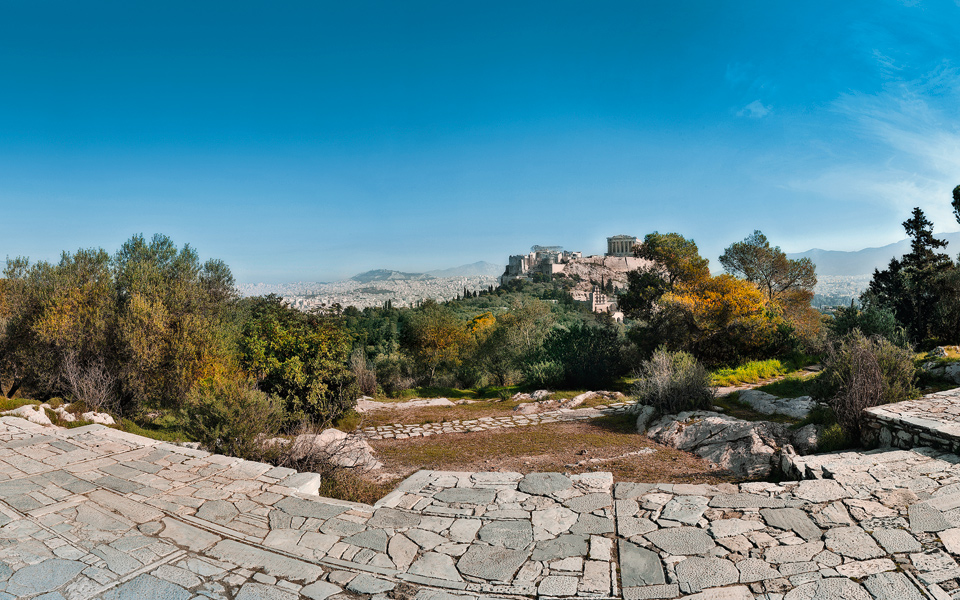
A view to the Acropolis, from the Hill of the Muses (Philopappos Hill). Mt Penteli rises in the distant background.
© Giannis Giannelos
Visitors with an appetite for Greece’s ancient past will discover a virtual smorgasbord of experiences to choose from, given all the archaeological sites, scenic historic spots and freshly refurbished museum galleries now available around Athens. Even with only a few days of “site-seeing” time, there are certain key places not to be missed, as you explore the narrow streets, piney slopes and marble monuments that give the city a sense of timelessness. Εven visitors who think they already know what to expect will discover Athens holds many archaeological surprises and opportunities for new understandings, from inspiring hilltop ruins, to towering Corinthian columns, to richly illustrated Byzantine manuscripts, all in the midst of the bustling modern city cityscape.
Topping the list is the Acropolis: one should always begin with a pilgrimage to the most perfect marble temple ever built, or to have survived condemning Christians, destructive conflagrations or Venetian bomb blasts. But don’t make straight for the Parthenon and miss all the intriguing other details to be noted during your walkabout. The Theater of Dionysus and the stone arches of Herodes Atticus’ music hall lie just beside the path, as you tread up the South Slopes in the footsteps of probably every prominent ancient Athenian to have left their mark on history.
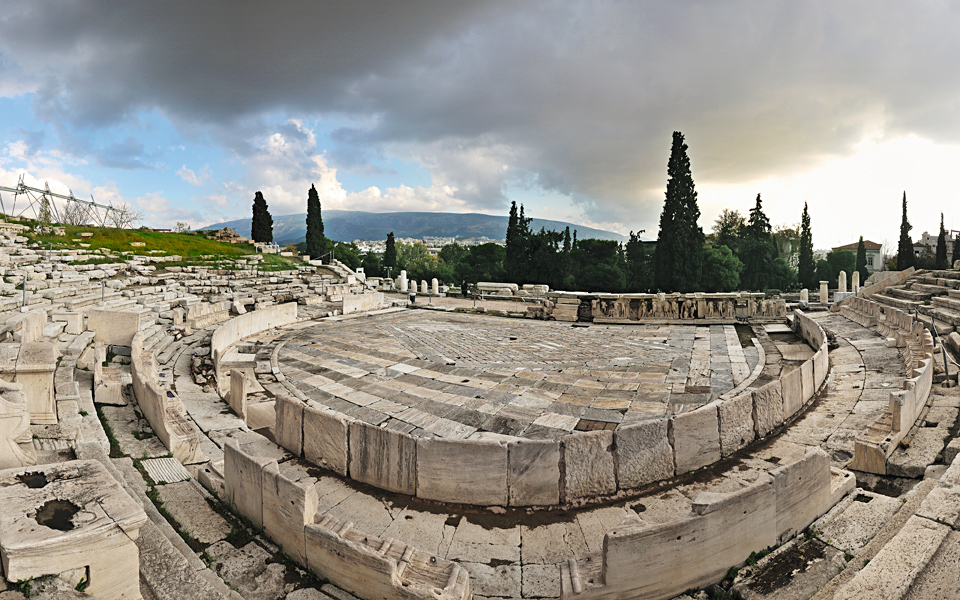
The Roman-period orchestra of the Theater of Dionysus, where dramas, gladiators, wild animals and mock sea battles were regular fare.
“Εven visitors who think they already know what to expect will discover Athens holds many archaeological surprises”
Beginning about 2,500 years ago, this was an area of Athens frequented by playwrights, city leaders, social critics, would-be brides and many other inhabitants or visitors seeking musical entertainment, drama, laughter, religious fulfillment or medical relief. The diminutive Sanctuary of Asclepius, once something of a hospice or health clinic, recalls to mind the terrible plague that swept through the walled-in, war-torn city of Athens and claimed the life of its great leader Pericles in 429 BC.
As you climb higher, catch another glimpse of the Herodeion from above, with its rising tiers of marble seats: a benefaction Herodes made to the city in the name of his late Italian-born wife Regilla—herself a great public benefactress and the head priestess of Fortuna’s temple, whose ruins lie hidden on the wooded knoll beside the horseshoe-shaped Panathenaic Stadium, easily distinguishable from the Acropolis. On another pine-clad hill, as you look out to the sea, stands the curving, partly preserved facade of a monumental tomb belonging to Gaius Julius Antiochus Philopappos, a distinguished Athenian citizen and the exiled ruler of a Roman-occupied kingdom in Asia Minor.
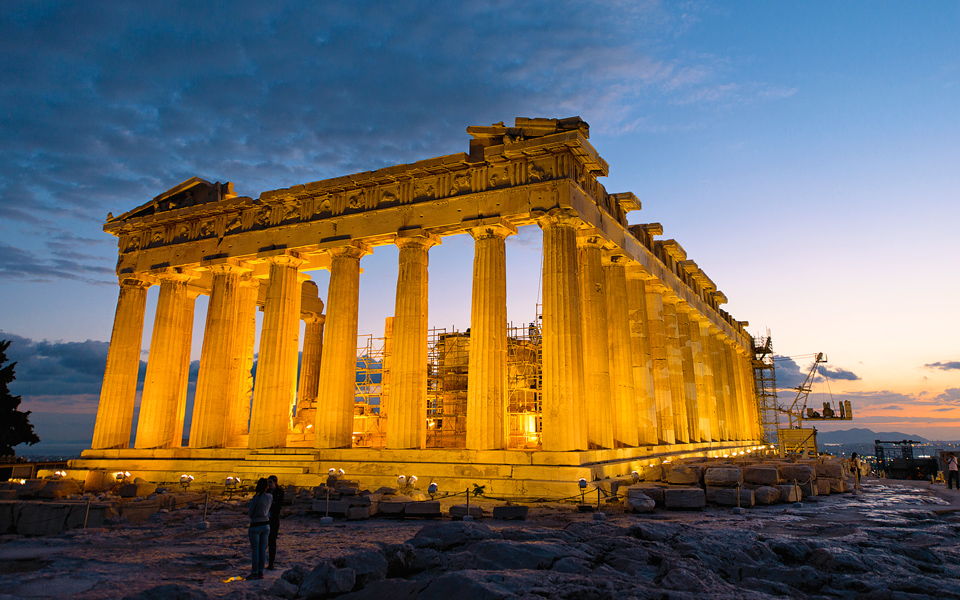
The Parthenon, aglow as dusk falls in Athens, with its beautifully restored north colonnade.
© Getty Images/Ideal Image
Passing upward through the Propylaia, be sure to notice its coffered ceiling and the exquisite Ionic styling of the Athena Nike Temple to the right, both newly restored by the present-day Acropolis team of cutting-edge architects, engineers, conservators and stonemasons. On emerging from the colonnaded gateway, there lie before you the jewels of the Sacred Rock: the Parthenon with its refined Doric architecture; the Erechtheion with its elegant Caryatids and moldings; and, from the Belvedere, one of the most panoramic views of age-old Athens and its surrounding hills.
Equally impressive experiences can be had at lower altitudes all around the Acropolis, especially at the Acropolis Museum. Here, you will reenact your earlier Acropolis ascent, as you move upward through the galleries, culminating with an opportunity to view the Parthenon’s remaining marbles up close and personal.
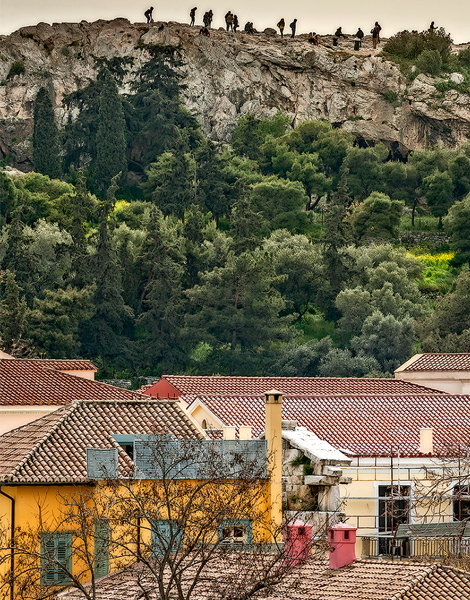
Plaka’s 19th- and early 20th-century townhouses, overshadowed by the rocky Areopagus Hill, the seat of ancient Athens’ highest court.
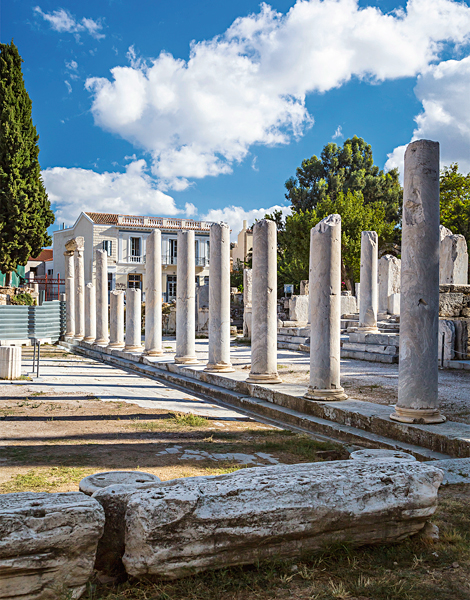
The Roman Agora, erected by Julius Caesar and Emperor Augustus; once the haunt of peddlers, prostitutes and ordinary Athenians.
“In the Athenian Agora one can almost feel the presence of Socrates, philosophically sparring with the city’s youth…or of Thespis, the world’s first award-winning actor…”
West of the Acropolis is the Hill of the Muses, whose summit carries the Philopappos monument and offers more inspiring views of the templed Sacred Rock. Also visible are the blue Saronic Gulf and Piraeus, home to ancient Athens’ triple-basined military/commercial port. Adjacent is the Pnyx Hill, which still retains the speakers’ rostrum and hillside auditorium of the popular assembly (Ekklesia), once echoing with the speeches of Pericles and Demosthenes.
On the north side of the Acropolis, in the Athenian Agora, the ancient city’s main public square, one can almost feel the presence of Socrates, philosophically sparring with the city’s youth in the House of Simon the Shoemaker, or of Thespis, the world’s first award-winning actor who performed along the Agora’s lanes. The Temple of Hephaestus and Athena (Hephaisteion), the best-preserved temple of ancient Greece, also deserves a visit, while the Stoa of Attalos and its galleries of objects illustrating daily life and the ways of democracy in ancient Athens should not be missed.
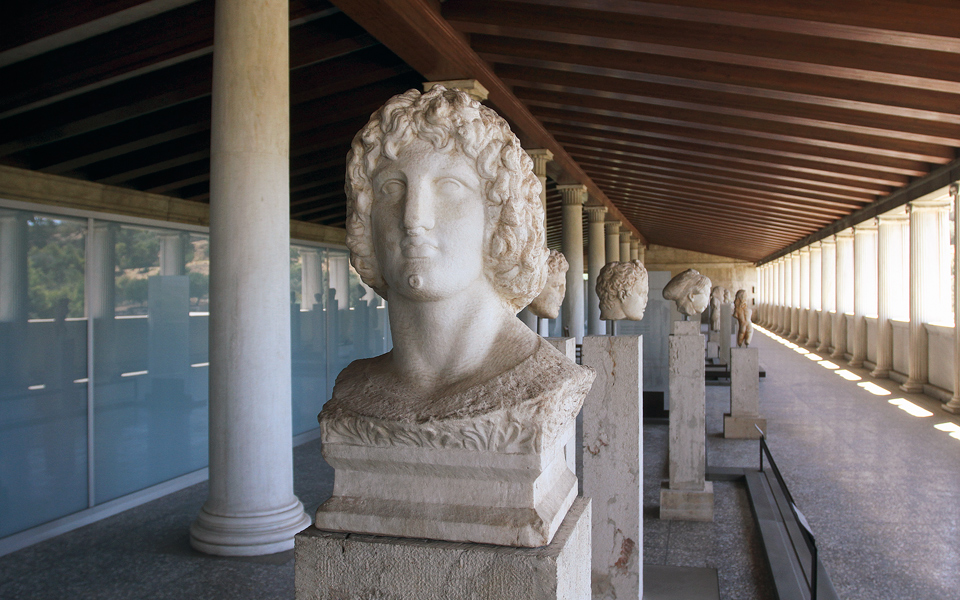
Sculptural displays in the Stoa of Attalos, an ancient, colonnaded shopping mall enclosing the east side of the Athenian Agora.
East of the Acropolis, as you meander through the winding streets of Plaka, the solitary Lysicrates Monument—a marble trophy-stand recognized today for its pioneering external use of the Corinthian style — not only stands as a tribute to past wealthy sponsors (choregoi) who financially backed ancient Athens’ theatrical performances, but also calls to mind Lord Byron. The flamboyant English nobleman once used this diminutive monument’s internal space as a study — in the early 19th century, when a Capucine convent had grown up around the 4th century BC structure and rented rooms to visitors. Further east tower the massive Corinthian columns of the Olympieion, beside which one feels dwarfed in the shadow of such an ambitious building project. As recently as the mid-19th century, a monk still carrying on the ancient Stylite tradition sought a secluded refuge atop the columns, closer to God, and had his daily sustenance raised to him in basket.
The city’s most notable museums include the foremost National Archaeological Museum, where you will meet such prototypical works of art as the handsome Zeus/Poseidon, the Boxing Boys of Akrotiri and the amused Aphrodite slapping at Pan. Perhaps Athens’ most visually striking museum experience, however, can be had at the Byzantine and Christian Museum, where a resplendent array of artifacts are notable for their rich colors, golden surfaces and enormous spiritual and historical value.
ΤHE ACROPOLIS Tel. (+30) 210.321.4172 • Open daily 8:00-15:00 (winter) 8:00-20:00 (summer) • Admission full €20, reduced €10 (This ticket allows admission to all main archaeological sites, seven days a week)
ACROPOLIS MUSEUM 15 Dionysiou Areopagitou • Tel. (+30) 210.900.0900 • Admission €5 • Open April 1 – October 31 Mondays 8:00-14:00, Tuesdays-Sundays 8:00-20:00, Fridays 8:00-22:00; November 1 – March 31 Mondays-Thursdays 9:00-17:00, Fridays 9:00-22:00, Saturdays & Sundays 9:00-20:00 (Last admission is half an hour before closing)
ATHENIAN AGORA AND MUSEUM 24 Adrianou • Tel. (+30) 210.321.0185 • Open daily 8:00-15:00 (winter) 8:00-20:00 (summer) • Admission full €8, reduced €4 (Includes admission to all the main archaeological sites in the historical center)
OLYMPIEION Entrance from Vassilissis Olgas Avenue • Tel. (+30) 210.922.6330 • Open daily 8:00-15:00 (winter) 8:00-20:00 (summer)
• Admission full €6, reduced €3
BYZANTINE AND CHRISTIAN MUSEUM 22 Vassilissis Sofias • Tel. (+30) 213.213.9500 • Open Tue-Sun 9:00-16:00
• Admission full €8, reduced €4
NATIONAL ARCHAEOLOGICAL MUSEUM 44 Patission • Tel. (+30) 213.214.4800 • Open Mon 13:00-20:00, Tue-Sun 9:00-16:00
• Admission full €10, reduced €5
Since 1928, this family-run wine taverna...
Discover how Christos, Athens’ master souvlaki...
Lost to earthquakes, swallowed by the...
Landmark shops, a lively cultural scene...